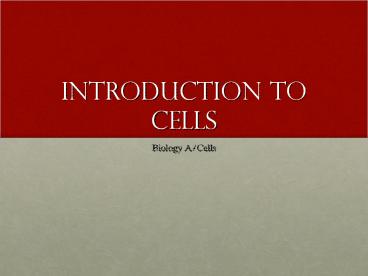Introduction%20to%20Cells - PowerPoint PPT Presentation
Title:
Introduction%20to%20Cells
Description:
Introduction to Cells Biology A/Cells Cross off Protists section Cross off Protists section The Discovery Cells were first discovered in 1665 when Robert Hooke ... – PowerPoint PPT presentation
Number of Views:179
Avg rating:3.0/5.0
Title: Introduction%20to%20Cells
1
Introduction to Cells
- Biology A/Cells
2
The Discovery
- Cells were first discovered in 1665 when Robert
Hooke observed a slice of cork under a
microscope. - Hooke thought the small divisions looked like the
monastery cells that monks lived in.
3
The Discovery
- Anton van Leeuwenhoek was the first to observe
micro-organisms in 1674, when he observed a drop
of water under a microscope.
4
The Discovery Continues
- The combined work of a number of other scientists
finally led to the development of the cell theory.
5
The Cell Theory
- All living things are made of cells.
- Cells are the basic units of structure and
function in living things. - New cells are only produced by other cells.
6
Micro-organisms
- We will discuss 3 main types of micro-organisms
- 1. Viruses
- 2. Bacteria
- 3. Protists
7
Bacteria
- Bacteria are microscopic, single-celled
organisms. - Bacteria are prokaryotes which means that their
DNA is not contained inside the protective
coating of a nucleus.
8
- Cross off Protists section ?
9
Viruses
- Viruses are the simplest and smallest
micro-organisms. - They contain a small amount of DNA (genetic
material) and a protective coat called a capsid. - Viruses reproduce by attaching to another cell
and overriding normal cell functioning so that
the cell produces new viruses.
10
2 Categories of Cells
- Prokaryotic Cells Eukaryotic Cells
11
Prokaryotic Cells
- Do not contain a nucleus
- Are smaller and simpler than eukaryotic cells
- Example Bacteria
12
Eukaryotic Cells
- Have a nucleus
- Are larger and more complex than prokaryotic
cells - Contain specialized structures called organelles
- Examples Plant cells
- Animal cells
13
(No Transcript)
14
Protists
- Protists are generally larger than viruses and
bacteria, but they are still microscopic. - Protists are eukaryotes, which means their DNA is
contained in a protective nucleus.

